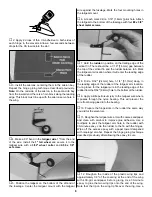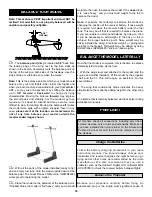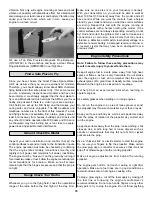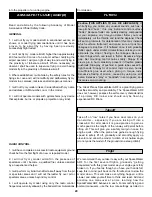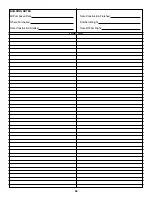
into the propeller of a running engine.
Read and abide by the following Academy of Model
Aeronautics Official Safety Code:
GENERAL
1. I will not fly my model aircraft in sanctioned events, air
shows, or model flying demonstrations until it has been
proven to be airworthy by having been previously
successfully flight tested.
2. I will not fly my model aircraft higher than approximately
400 feet within 3 miles of an airport without notifying the
airport operator. I will give right of way to and avoid flying in
the proximity of full-scale aircraft. Where necessary an
observer shall be used to supervise flying to avoid having
models fly in the proximity of full-scale aircraft.
3. Where established, I will abide by the safety rules for the
flying site I use and I will not willfully and deliberately fly my
models in a careless, reckless and/or dangerous manner.
7. I will not fly my model unless it is identified with my name
and address or AMA number, on or in the model.
9. I will not operate models with pyrotechnics (any device
that explodes, burns, or propels a projectile or any kind).
RADIO CONTROL
1. I will have completed a successful radio equipment ground
check before the first flight of a new or repaired model.
2. I will not fly my model aircraft in the presence of
spectators until I become a qualified flier, unless assisted
by an experienced helper.
3. I will perform my initial turn after takeoff away from the pit
or spectator areas and I will not thereafter fly over pit or
spectator areas, unless beyond my control.
4. I will operate my model using only the radio control
frequencies currently allowed by the Federal Communications
Commission.
The Great Planes SpaceWalker ARF is a great-flying plane
that flies smoothly and predictably. The SpaceWalker ARF
does not, however, possess the self-recovery characteristics
of a primary R/C trainer and should only be flown by
experienced RC Pilots.
Take off on “low” rates if you have dual rates on your
transmitter – especially if you are taking off into a
crosswind. For all models it is good practice to gain as
much speed as the length of the runway will permit before
lifting off. This will give you a safety margin in case the
engine quits. When the plane has gained enough flying
speed to safely lift off, gradually and smoothly apply up
elevator and allow the model to climb at a shallow angle
(do not yank the model off the ground into a steep climb!)
We recommend that you take it easy with your SpaceWalker
ARF for the first several flights, gradually “getting
acquainted” with this great model as your engine gets fully
broken in. If you feel as though you have your hands full,
keep this in mind: pull back on the throttle stick to slow the
model down. This will make everything happen a little
slower and allow yourself time to think and react. Add and
practice one maneuver at a time, learning how the
SpaceWalker ARF behaves in each. For smooth flying and
normal maneuvers, use the low rate settings as listed on
Flight
Takeoff
Caution (THIS APPLIES TO ALL R/C AIRPLANES):
If,
while flying, you notice any unusual sounds, such as a
low-pitched “buzz,” this may indicate control surface
“flutter.” Because flutter can quickly destroy components
or your airplane, any time you detect flutter you must
immediately cut the throttle and land the airplane! Check
all servo grommets for deterioration (this may indicate
which surface fluttered) and make sure all pushrod
linkages are slop-free. If it fluttered once, it will probably
flutter again under similar circumstances unless you can
eliminate the slop or flexing in the linkages. Here are
some things which can result in flutter: Excessive hinge
gap; Not mounting control horns solidly; Sloppy fit of
clevis pin in horn; elasticity present in flexible plastic
pushrods; Side-play of pushrod in guide tube caused by
tight bends; Sloppy fit of control rods in servo horns;
Insufficient glue used when gluing in torque rods;
Excessive flexing of aileron, caused by using too soft
balsa; Excessive “play” or “backlash” in servo gears; and
insecure servo mounting.
FLYING
AMA SAFETY CODE (excerpt)
20




